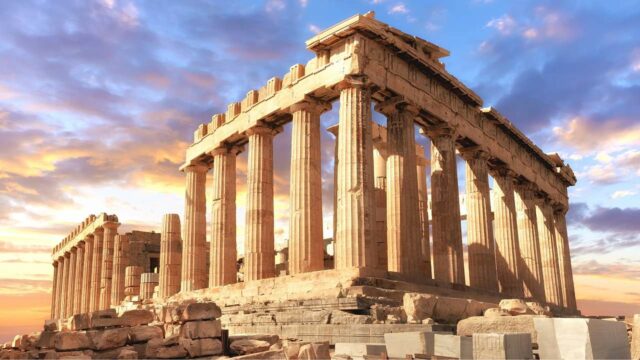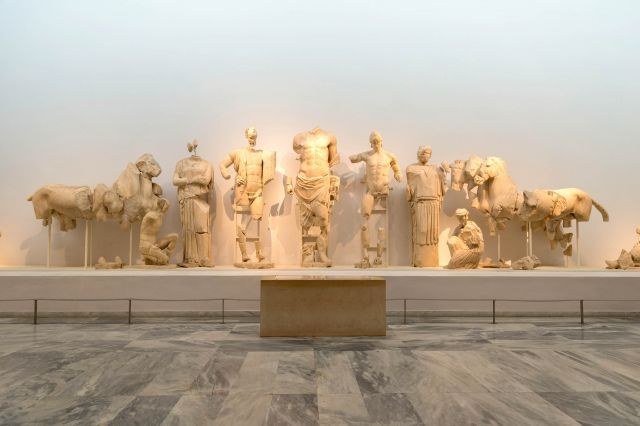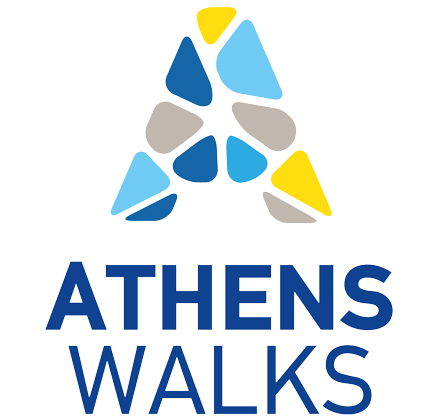
Credit: Destguides.gr
Greece is synonymous with ancient history and famous landmarks and is the birthplace of western civilization. Significant and historically important european monuments lie across the entirety of the country and attract hordes of tourists all year round. The list of Greek monuments is endless and includes a vast number of remnants that cover a large time period, from early stone age up to Roman times. Enticing old temples and palaces, to mediaeval castles and coastal cities, in combination with the enticing Greek islands, all make Greece a must-visit place as it is endowed with a glorious cultural and historical heritage which is best preserved in its monuments. Even though it’s impossible to distinguish the best among them all, we have selected the 5 best historical monuments in Greece that should definitely be part of your itinerary on your next vacation to Greece.
Written by Savina Skourmalla on 21-12-2022
- Best historical monuments in Greece – Acropolis of Athens

Credit: Iteuropa.com
The capital of Greece, Athens, is home to some of the most important and world-famous monuments in the world and thus attracts travellers any time of the year. There is however one distinguished monument that is not only the jewel of the city, but is also the absolute symbol of ancient and modern Greek culture and society. I’m talking about the Acropolis of Athens and the Parthenon that stands proudly on top of Acropolis hill, which serves as Athens’ landmark and undoubtedly the best monument in Greece that adorns the modern metropolitan city from above. The Acropolis of Athens is not only vital to Greek history, but is also one of the most historically important monuments in the world. When one visits Athens, the Acropolis is on top of their visit list, if not first. There is an immense historical and educational gravity within the monuments that embellish the rock, like the Theatre of Dionysus, the Temple of Asclepius and the Odeon of Herodes Atticus, the Temple of Athena Nike, the Propylaea, the Erechtheion and of course the Parthenon, the most mentioned and photographed monument in Greece.

Credit: GreeceIs.com
The monument of Parthenon was constructed during the ‘golden age’ of ancient Greece (5th century B.C) and it was dedicated to Athena, the protective goddess from whom the city got its name. It was made entirely out of Pentelic marble and it’s fascinating how it managed to survive several distructions and even a bombing during the Ottoman occupation. It was during that time, also where the infamous Lord Elgin received a questionable permission from the ‘Sultan’ to obtain an important number of marbles that reside in the British Museum today. The ongoing ‘battle’ for the return of the marbles was reignited after the opening of the brand new, state-of-the- Acropolis Museum but no solution has been reached yet.
With its historical, cultural and architectural importance, the Parthenon has managed to make it to the UNESCO Heritage Monuments list as the most important monument in Greece. Protected by the law, the Archaeological Society of Athens and the European Union, an organised effort to preserve and restore buildings is made in order for the Parthenon to continue standing for many years to come and for the Acropolis to bear the title of the best monument in Greece.
If you wish to explore the Acropolis hill in the most fun and unique way, you could try Acropolis by Bike, the only tour in Athens that combines the thrill of cycling with a guided tour to the sacred rock and the Parthenon.In this unique bike tour of Athens, you will have the opportunity to learn about the ancient and modern city in the most fun and exciting way!
For ticket information and opening hours click here.
- Best historical monuments in Greece – Delphi
The second most important monument is Greece and home of the spectacular oracle of Apollo is the sanctuary of Delphi. Located on the slopes of Mount Parnassus, Delphi is one of the most ancient and historic sites with heavy religious importance for ancient Greece. In the past it was considered ‘the centre of the earth’ and constituted as the spiritual centre of the Greek world as it was home of the most famous oracle in the country, dedicated to the Olympian god Apollo. This is where profound military and political figures from all over the Mediterranean would gather to receive a prophecy and advice regarding their choices and course of action in exchange of gifts, much like how a modern fortune-teller works!

Credit: Travelthegreekway.com
The principal monument of Delphi, the temple of Apollo was home to the high priestess ‘Pythia’ who was believed to be ‘possessed’ by the god and worked as a portal between the divine and the earthly. Another key monument is the Treasury of Athens, a doric type temple made out of marble in which all the offerings were held and a symbol of Greek democracy as it was one of the first buildings created by sponsorship from Athens.
Next to Apollo’s temple lie the marvellous Theater and the Stadium of Delphi, two of the most important monuments of their kind in Greece. This is where the ‘Pythian Games’ took place, an event that could host up to 5.000 spectators! The Tholos of Delphi is probably the most interesting architectural monument on the site and one of the most iconic buildings in Greece. Its circular construction results in a mesmerising effect and it’s perfect for memorable photos!
The Archaeological Museum of Delphi is a first class museum and one of the best museums in Greece and hosts numerous findings of the excavations on the site. This museum is considered an ambassador of ancient Greek art as its home of artefacts found in school books all over the world such as the Charioteer of Delphi and the golden and ivory statues of Apollo and Artemis.

Credit: Discovergreece.com
The archaeological site of Delphi is located next to a beautiful and picturesque village called Arachova which is located on the mountain and is the perfect winter escape for ski goers and hikers who wish to escape in a true winter wonderland. Make sure to visit this lovely village on your way back from Delphi to complete your trip in the best possible way.
If you wish to discover and fully experience the site of Delphi, all of the sites mentioned above, as well as stop by the village of Arachova, you can join our Delphi Day Trip from Athens.This full-day guided tour will definitely be one of your highlights in Athens and a great way to explore one of the best monuments in Greece!
.
For ticket information and opening hours click here.
- Best historical monuments in Greece – Minoan Palace in Knossos
Crete is the largest Greek island and certainly one of the most beautiful and visited. Besides sunny beaches and lovely scenic views, Crete is also home to some of the most important monuments in Greece. The one that shines over all others is the mysterious and alluring Palace of Knossos.

Credit: Lonelyplanet.com
This monument with the vivid red hues is the most important site on the island and is linked to one of the most famous myths of Greek antiquity, that of the Theseus and the Minotaur. Knossos was not just a royal house, but it was the meeting point and administrative centre where the political heart of Crete beat. The site was lost for many centuries until it was discovered by Sir Arthur Evans almost intact and covered in ashes. There is a mystery around its disappearance, but most believe that most of the site was destroyed when the volcano in Santorini erupted and caused a tsunami. Just like in Pompei, the ashes preserved the site and that’s why we are able to see the bright red colours and paintings on the walls up to this day, making the Palace of Knossos one of the most beautiful and important architectural monuments in Greece.

Credit: Worldhistory.org
Arthur Evans did not just excavate the site, but his role was far more stretched and engaging when it comes to the history of the site and how we see it today. It was he who gave the name ‘Minoan’ to the civilization of the Aegean Bronze Age, when the Palace of Knossos was built, and the name is used by academics today, putting Knossos in the centre of historical discussions and debates. The most important intervention from Evans has been the partial reconstruction of the palace during the 18th century, during which he turned Knossos into what he imagined the ancient place to look like. What we see today therefore is a vast complex of 1300 rooms connected by corridors and frescoes with bright colours that sadly have little connection to the harmonious and balanced manners and styles of most Greek sites.
There are many incredible monuments and artefacts to see at the archaeological site of Knossos. Here you will have the opportunity to explore the central and west Courts of the Minoan Palace, Evans’ reconstructed Piano Nobile and the Royal Rooms. The Throne Room in particular is the most impressive room in the entire site and where you will be able to see vibrant frescoes and an ornate stone throne. Another spectacular thing to see is the ancient drain system that provided the Palace with running water and sewage. This means that there was a fully working toilet and shower system in the Palace way before it became widespread during the 17th century!
Once in Crete, don’t forget to check the Heraklion Archaeological Museum that is home to the relics and findings (like the Disc of Phaistos) of this important monument and is considered one of the best museums in Europe
For ticket information and opening hours click here.
- Best historical monuments in Greece – Ancient Olympia
Everyone knows about the Olympic Games and how they originated from Greece, but few know about its birthplace, Ancient Olympia in Peloponnese. The first ancient Olympic Games were held in Olympia in 776 BC and were organised to honour the father of the Gods, Zeus, every four years, a timeline that inspired modern Olympic Games. The Olympics used to be the biggest athletic and cultural event of that time and that’s why Ancient Olympia used to be one of the most sacred sites in antiquity and one of the best historical monuments in Greece today.

Credit: Olympics.com
The sport competitions held in Olympia were a very important part of Greek cities who competed with each other and it was considered a great honour for the city-state if their athlete won in the games. The participants were only men, as women were banned from the games and even the audience. The games started with simple running races but gradually, more events were incorporated in the athletic program of the games.
Today, the large complex of the Archaeological site of Olympia includes a variety of buildings and ancient monuments expanding in a large area that is perfect for a walk where nature and ancient ruins combine.

Credit: Aton.gr
The most important monument on site is the Temple of Zeus not because of its structure or architectural importance, but because it used to house a large gold and ivory statue of Zeus which was assigned to the same artist that created the statue of Athena that adorned the interior of the Parthenon. Unfortunately this statue that was once considered one of the 7 wonders of the world, was destroyed during the Byzantine times.
The Ancient Stadium is another significant monument on the site that really captures the essence of the area. Most of the sport events of the ancient Olympics took place in this stadium, the races, the pentathlon, the javelin and the shot-put event to name a few. The last game was also organised on the same spot in the modern version of the Olympic games that were held in Athens in 2004.

Credit: Greeka.com
There were also horse and chariot races that were held in the hippodrome but there are no remains left of this important part of the complex. There are numerous other monuments, temples, sanctuaries, statues and ceremonial constructions, as well as more information and findings about Ancient Olympia can be found in the Archaeological Museum of Olympia. Upon visiting the museum you will learn about the history of the Olympic Games and marvel at sculptures and vast collections that will expand your knowledge around the games and how the Olympic events were connected to the cult of Zeus. There are two other museums, the Museum of the history of the Olympic Games of Antiquity and the Museum of Excavation History in Olympia that will complete your educational journey to this fantastic monument.
Because of its location, Olympia is unfortunately not on the top of the list of visitors planning their trip to Greece. Since it involves some degree of difficulty to get there and lots of travel time, it is best for those who are spending many days in Greece and have the time to spend visiting the site. If you are willing to spend a day to visit the site however, you will be awarded with an unforgettable experience to one of the most exciting and best monuments in Greece.
For ticket information and opening hours click here.
- Best historical monuments in Greece – Palace of the Grand Master of Knights, Rhodes

Credit: Romios Restaurant
I chose to end this small yet useful guide to the best historical monuments of Greece with one that’s different from the others mentioned and not as ancient, but it’s definitely one of the most important and beautiful structures in the entirety of the country. In the island of Rhodes, the biggest of the Dodecanese complex, the first thing that welcomes visitors who travel by boat is the imposing mediaeval castle, or the Palace of the Grand Master of Knights as its official name is. This imposing and fully reconstructed mediaeval castle which is found at the end of the Knight’s Street, is not just an emblematic jewel of the island and its history, but also one of the most historical monuments in Greece with immense architectural significance.
The castle which was built during the 14th century during the Venetian occupation by the Knights of St John survived many battles and attacks until it was almost entirely destroyed during the 19th century during a bombing. However, the castle that was then used as a fortress and gave refuge to the habitants of the island was fully restored and today it houses a truly impressive museum.

Credit: Greece Is
The palace played an important role in the fortification of the island but also functioned as the social and cultural centre of Rhodes, besides being the residence of the Grand Master of the Knights. During the Ottoman period the castle lost its mediaeval shine and was turned into a prison until it was constructed during the Italian occupation.
The building itself is an architectural wonder with a tower-shaped rectangular shape and a huge courtyard in the middle which is surrounded by rooms and galleries. The floors on most of the rooms are covered in beautiful mosaics which were brought by the neighbouring island of Kos, renowned for its courtyards.

Credit: Fineartamerica.com
The castle has turned into a beautiful museum including the history of the mediaeval period as well as the different phases the building went through. There is weaponry, books, paintings and other relics exhibited in the museum and are visited by several tourists who spend their holidays on the island.
For ticket information and opening hours click here.

